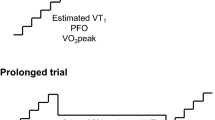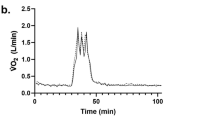Abstract
In this study we investigated the effect of pedal cadence on the cycling economy, accumulated oxygen deficit (AOD), maximal oxygen consumption (V˙O2max) and blood lactate transition thresholds of ten high-performance junior endurance cyclists [mean (SD): 17.4 (0.4) years; 183.8 (3.5) cm, 71.56 (3.75) kg]. Cycling economy was measured on three ergometers with the specific cadence requirements of: 90–100 rpm for the road dual chain ring (RDCR90–100rpm) ergometer, 120–130 rpm for the track dual chain ring (TDCR120–130rpm) ergometer, and 90–130 rpm for the track single chain ring (TSCR90–130rpm) ergometer. AODs were then estimated using the regression of oxygen consumption (V˙O2) on power output for each of these ergometers, in conjunction with the data from a 2-min supramaximal paced effort on the TSCR90–130rpm ergometer. A regression of V˙O2 on power output for each ergometer resulted in significant differences (P<0.001) between the slopes and intercepts that produced a lower AOD for the RDCR90–100rpm [2.79 (0.43) l] compared with those for the TDCR120–130rpm [4.11 (0.78) l] and TSCR90–130rpm [4.06 (0.84) l]. While there were no statistically significant V˙O2max differences (P = 0.153) between the three treatments [RDCR90–100rpm: 5.31 (0.24) l · min−1; TDCR120–130rpm; 5.33 (0.25) l · min−1; TSCR90–130rpm: 5.44 (0.27) l · min−1], all pairwise comparisons of the power output at which V˙O2max occurred were significantly different (P < 0.001). Statistically significant differences were identified between the RDCR90–100rpm and TDCR120–130rpm tests for power output (P = 0.003) and blood lactate (P = 0.003) at the lactate threshold (Thla−), and for power output (P = 0.005) at the individual anaerobic threshold (Thiat). Our findings emphasise that pedal cadence specificity is essential when assessing the cycling economy, AOD and blood lactate transition thresholds of high-performance junior endurance cyclists.
Similar content being viewed by others
Author information
Authors and Affiliations
Additional information
Accepted: 9 January 1999
Rights and permissions
About this article
Cite this article
Woolford, S., Withers, R., Craig, N. et al. Effect of pedal cadence on the accumulated oxygen deficit, maximal aerobic power and blood lactate transition thresholds of high-performance junior endurance cyclists. Eur J Appl Physiol 80, 285–291 (1999). https://doi.org/10.1007/s004210050594
Issue Date:
DOI: https://doi.org/10.1007/s004210050594




